Ageing Suitability Evaluation of Residential Districts Based on Active Ageing Theory
Abstract
1. Introduction
2. Literature Review
3. Methodology
3.1. Research Framework and Process
3.2. Systematic Literature Review
3.3. Purposive Sampling and Snowball Sampling
3.4. Questionnaire Survey
3.5. Principal Component Analysis
3.6. Grey Correlation Analysis
3.7. Collation of Evaluation Criteria
4. Case Study
4.1. Overview of the Selected District
4.1.1. Outdoor Environment
4.1.2. Activities
4.1.3. Infrastructure
4.2. The Process of Evaluation
5. Results and Discussion
5.1. Health
5.2. Participation
5.3. Security
6. Conclusions
Supplementary Materials
Author Contributions
Funding
Data Availability Statement
Conflicts of Interest
References
- Gu, D.; Andreev, K.; Dupre, M.E. Major trends in population growth around the world. China CDC Wkly. 2021, 3, 604–612. [Google Scholar] [CrossRef] [PubMed]
- Yoon, H.; Huber, L.; Kim, C. Sustainable aging and leisure behaviors: Do leisure activities matter in aging well? Sustainability 2021, 13, 2348. [Google Scholar] [CrossRef]
- World Health Organization. World Report on Ageing and Health; World Health Organization: Geneva, Switzerland, 2015; ISBN 9241565047. [Google Scholar]
- Are, C.; Chowdhury, S.; Ahmad, H.; Ravipati, A.; Song, T.; Shrikandhe, S.; Smith, L. Predictive global trends in the incidence and mortality of pancreatic cancer based on geographic location, socio-economic status, and demographic shift. J. Surg. Oncol. 2016, 114, 736–742. [Google Scholar] [CrossRef] [PubMed]
- Divo, M.J.; Martinez, C.H.; Mannino, D.M. Ageing and the epidemiology of multimorbidity. Eur. Respir. J. 2014, 44, 1055–1068. [Google Scholar] [CrossRef]
- Chen, J.; Li, Q. The connotations and eco-efficiency of urban residential district. In Proceedings of the International Conference on Construction and Real Estate Management, Bristol, UK, 21–22 August 2007; pp. 1731–1734. [Google Scholar]
- Dandan, F. Research on aging in place demand elements in china’s old city regeneration. J. Civ. Eng. Archit. 2021, 15, 469–474. [Google Scholar] [CrossRef]
- Altomonte, S.; Allen, J.; Bluyssen, P.M.; Brager, G.; Heschong, L.; Loder, A.; Schiavon, S.; Veitch, J.A.; Wang, L.; Wargocki, P. Ten questions concerning well-being in the built environment. Build. Environ. 2020, 180, 106949. [Google Scholar] [CrossRef]
- Airey, L.; Lain, D.; Jandrić, J.; Loretto, W. A selfish generation? ‘Baby boomers’, values, and the provision of childcare for grandchildren. Sociol. Rev. 2021, 69, 812–829. [Google Scholar] [CrossRef]
- Scharlach, A.E. Age-friendly cities: For whom? By whom? For what purpose? In Age-Friendly Cities and Communities in International Comparison; Springer: Berlin/Heidelberg, Germany, 2016; pp. 305–329. ISBN 978-3-319-24031-2. [Google Scholar]
- Smith, K.J.; Victor, C. Typologies of loneliness, living alone and social isolation, and their associations with physical and mental health. Ageing Soc. 2019, 39, 1709–1730. [Google Scholar] [CrossRef]
- Roy, N.; Dubé, R.; Després, C.; Freitas, A.; Légaré, F. Choosing between staying at home or moving: A systematic review of factors influencing housing decisions among frail older adults. PLoS ONE 2018, 13, e0189266. [Google Scholar] [CrossRef]
- Muñoz-Rodríguez, J.M.; Hernández-Serrano, M.J.; Tabernero, C. Digital identity levels in older learners: A new focus for sustainable lifelong education and inclusion. Sustainability 2020, 12, 10657. [Google Scholar] [CrossRef]
- Carbonell-Hernández, L.; Pastor, D.; Jiménez-Loaisa, A.; Ballester-Ferrer, J.A.; Montero-Carretero, C.; Cervelló, E. Lack of correlation between accelerometers and heart-rate monitorization during exercise session in older adults. Int. J. Environ. Res. Public Health 2020, 17, 5518. [Google Scholar] [CrossRef]
- Saberzadeh, V.; Sefiddashti, S.E.; Lari, M.S. Examining active aging among Iranian provinces: A TOPSIS analysis. BMC Public Health 2022, 22, 764. [Google Scholar] [CrossRef]
- Ding, X.; Ran, M. Research on the application of role theory in active aging education service system design. In Proceedings of the International Conference on Human-Computer Interaction, Electr Network, Singapore, 24–29 July 2021; pp. 205–222. [Google Scholar]
- Rantanen, T.; Saajanaho, M.; Karavirta, L.; Siltanen, S.; Rantakokko, M.; Viljanen, A.; Rantalainen, T.; Pynnönen, K.; Karvonen, A.; Lisko, I. Active aging–resilience and external support as modifiers of the disablement outcome: AGNES cohort study protocol. BMC Public Health 2018, 18, 565. [Google Scholar] [CrossRef]
- Kim, J.; Lee, H.; Cho, E.; Lee, K.H.; Park, C.G.; Cho, B.-H. Multilevel effects of community capacity on active aging in community-dwelling older adults in South Korea. Asian Nurs. Res. 2020, 14, 36–43. [Google Scholar] [CrossRef] [PubMed]
- Chen, N.; Chen, J.; Ko, P.C. Active aging in the countryside: Space, place and the performance of leisure–work lifestyles in contemporary rural China. Popul. Space Place 2021, 27, e2429. [Google Scholar] [CrossRef]
- Qiao, G.; Ding, L.; Xiang, K.; Prideaux, B.; Xu, J. Understanding the value of tourism to seniors’ health and positive aging. Int. J. Environ. Res. Public Health 2022, 19, 1476. [Google Scholar] [CrossRef]
- Chen, Y.; Hicks, A.; While, A.E. Loneliness and social support of older people in China: A systematic literature review. Health Soc. Care Community 2014, 22, 113–123. [Google Scholar] [CrossRef] [PubMed]
- Ko, P.-C.; Yeung, W.-J.J. An ecological framework for active aging in China. J. Aging Health 2018, 30, 1642–1676. [Google Scholar] [CrossRef] [PubMed]
- Ashida, S.; Sewell, D.K.; Schafer, E.J.; Schroer, A.; Friberg, J. Social network members who engage in activities with older adults: Do they bring more social benefits than other members? Ageing Soc. 2019, 39, 1050–1069. [Google Scholar] [CrossRef]
- Zhang, L.; Lin, Y.; Hooimeijer, P.; Geertman, S. Heterogeneity of public participation in urban redevelopment in Chinese cities: Beijing versus Guangzhou. Urban Stud. 2020, 57, 1903–1919. [Google Scholar] [CrossRef]
- De Haas, W.; Hassink, J.; Stuiver, M. The role of urban green space in promoting inclusion: Experiences from the netherlands. Front. Environ. Sci. 2021, 9, 618198. [Google Scholar] [CrossRef]
- Carandang, R.R.; Asis, E.; Shibanuma, A.; Kiriya, J.; Murayama, H.; Jimba, M. Unmet needs and coping mechanisms among community-dwelling senior citizens in the philippines: A qualitative study. Int. J. Environ. Res. Public Health 2019, 16, 3745. [Google Scholar] [CrossRef] [PubMed]
- Hu, J.; Zhang, Y.; Wang, L.; Shi, V. An evaluation index system of basic elderly care services based on the perspective of accessibility. Int. J. Environ. Res. Public Health 2022, 19, 4256. [Google Scholar] [CrossRef]
- Levinger, P.; Dunn, J.; Panisset, M.; Dow, B.; Batchelor, F.; Biddle, S.J.H.; Duque, G.; Hill, K.D. Challenges and lessons learnt from the ENJOY project: Recommendations for future collaborative research implementation framework with local governments for improving the environment to promote physical activity for older people. BMC Public Health 2021, 21, 1192. [Google Scholar] [CrossRef] [PubMed]
- Seah, B.; Espnes, G.A.; Ang, E.N.K.; Lim, J.Y.; Kowitlawakul, Y.; Wang, W. Supporting the mobilization of health assets among older community dwellers residing in senior-only households in Singapore: A qualitative study. BMC Geriatr. 2020, 20, 411. [Google Scholar] [CrossRef]
- Ruengtam, P. Factor analysis of built environment design and management of residential communities for enhancing the wellbeing of elderly people. In Proceedings of the International High-Performance Built Environment Conference (iHBE), Sydney, Australia, 17–18 November 2016; pp. 966–974. [Google Scholar]
- Seah, B.; Kowitlawakul, Y.; Jiang, Y.; Ang, E.; Chokkanathan, S.; Wang, W. A review on healthy ageing interventions addressing physical, mental and social health of independent community-dwelling older adults. Geriatr. Nurs. 2019, 40, 37–50. [Google Scholar] [CrossRef] [PubMed]
- Pan, L.; Sun, J.; Zhou, R. Research on the construction of age-friendly community based on fuzzy comprehensive evaluation model: Evidence from community in Hefei of China. Risk Manag. Healthc. Policy 2021, 14, 3841–3852. [Google Scholar] [CrossRef] [PubMed]
- So, K.-S.; Shin, S. Development of a sustainable aged residential model considering aged-friendly environmental factors. In Proceedings of the Global Conference on Civil, Structural and Environmental Engineering/3rd International Symp on Multi-field Coupling Theory of Rock and Soil Media and Its Applications, Yichang, China, 20–21 October 2012; pp. 75–82. [Google Scholar]
- Gardner, P. The role of social engagement and identity in community mobility among older adults aging in place. Disabil. Rehabil. 2014, 36, 1249–1257. [Google Scholar] [CrossRef]
- Karma, B.; Ada-Katrin, B.; Handler-Schuster, D. Exploring Health-related needs of elderly people (70+) at home: A qualitative study from Switzerland. J. Prim. Care Community Health 2021, 12, 21501327211055635. [Google Scholar] [CrossRef]
- Chen, Y.; Bouferguene, A.; Shirgaokar, M.; Al-Hussein, M. Spatial analysis framework for age-restricted communities integrating spatial distribution and accessibility evaluation. J. Urban Plan. Dev 2020, 146, 15. [Google Scholar] [CrossRef]
- Flores, R.; Caballer, A.; Alarcon, A. Evaluation of an age-friendly city and its effect on life satisfaction: A two-stage study. Int. J. Environ. Res. Public Health 2019, 16, 5073. [Google Scholar] [CrossRef] [PubMed]
- Levinger, P.; Dunn, J.; Abfalter, E.; Dow, B.; Batchelor, F.; Garratt, S.; Diamond, N.T.; Hill, K.D. The enjoy map for health: Exercise intervention outdoor project in the community for older people-More active people for healthier communities: A study protocol. BMC Public Health 2022, 22, 1027. [Google Scholar] [CrossRef] [PubMed]
- Lindsay-Smith, G.; Eime, R.; O’Sullivan, G.; Harvey, J.; van Uffelen, J.G.Z. A mixed-methods case study exploring the impact of participation in community activity groups for older adults on physical activity, health and wellbeing. BMC Geriatr. 2019, 19, 243. [Google Scholar] [CrossRef]
- Mahmood, A.; Chaudhury, H.; Michael, Y.L.; Campo, M.; Hay, K.; Sarte, A. A photovoice documentation of the role of neighborhood physical and social environments in older adults’ physical activity in two metropolitan areas in North America. Soc. Sci. Med. 2012, 74, 1180–1192. [Google Scholar] [CrossRef]
- Bammann, K.; Recke, C.; Albrecht, B.M.; Stalling, I.; Doerwald, F. Promoting physical activity among older adults using community-based participatory research with an adapted PRECEDE-PROCEED model approach: The AEQUIPA/OUTDOOR ACTIVE project. Am. J. Health Promot. 2021, 35, 409–420. [Google Scholar] [CrossRef]
- Van Holle, V.; Van Cauwenberg, J.; Van Dyck, D.; Deforche, B.; Van de Weghe, N.; De Bourdeaudhuij, I. Relationship between neighborhood walkability and older adults’ physical activity: Results from the belgian environmental physical activity study in seniors (BEPAS Seniors). Int. J. Behav. Nutr. Phys. Act. 2014, 11, 1–9. [Google Scholar] [CrossRef]
- Wilson, M.L.; Strayer, T.E., III; Davis, R.; Harden, S.M. Use of an integrated research-practice partnership to improve outcomes of a community-based strength-training program for older adults: Reach and effect of lifelong improvements through fitness together (LIFT). Int. J. Environ. Res. Public Health 2018, 15, 237. [Google Scholar] [CrossRef] [PubMed]
- Vegi, A.S.F.; Filho, E.I.F.; Pessoa, M.C.; Ramos, K.L.; Ribeiro, A.Q. Walkability and healthy aging: An analytical proposal for small and medium-sized Brazilian cities. Cad. Saude Publica 2020, 36, 15. [Google Scholar] [CrossRef]
- Lee, J.E.; Kahana, B.; Kahana, E. Successful aging from the viewpoint of older adults: Development of a brief Successful Aging Inventory (SAI). Gerontology 2017, 63, 359–371. [Google Scholar] [CrossRef]
- Michele, J.; Guillaume, M.; Alain, T.; Nathalie, B.; Claude, F.; Kamel, G. Social and leisure activity profiles and well-being among the older adults: A longitudinal study. Aging Ment. Health 2019, 23, 77–83. [Google Scholar] [CrossRef]
- Byles, J.E.; Mackenzie, L.; Redman, S.; Parkinson, L.; Leigh, L.; Curryer, C. Supporting housing and neighbourhoods for healthy ageing: Findings from the Housing and Independent Living Study (HAIL). Australas. Ageing 2014, 33, 29–35. [Google Scholar] [CrossRef] [PubMed]
- Park, S.; Ko, Y. The sociocultural meaning of "My Place": Rural Korean elderly people’s perspective of aging in place. Asian Nurs. Res. 2020, 14, 97–104. [Google Scholar] [CrossRef] [PubMed]
- Gomez-Morales, A.; de Miranda, J.M.A.; Pergola-Marconato, A.M.; Mansano-Schlosser, T.C.; Mendes, F.R.P.; Torres, G.d.V. The influence of activities on the quality of life of the elderly: A systematic review. Cienc. Saude Coletiva 2019, 24, 189–202. [Google Scholar] [CrossRef]
- Dattilo, J.; Lorek, A.E.; Mogle, J.; Sliwinski, M.; Freed, S.; Frysinger, M.; Schuckers, S. Perceptions of Leisure by Older Adults Who Attend Senior Centers. Leis. Sci. 2015, 37, 373–390. [Google Scholar] [CrossRef]
- Campbell, S.; Greenwood, M.; Prior, S.; Shearer, T.; Walkem, K.; Young, S.; Bywaters, D.; Walker, K. Purposive sampling: Complex or simple? Research case examples. J. Res. Nurs. 2020, 25, 652–661. [Google Scholar] [CrossRef]
- Hennink, M.M.; Kaiser, B.N.; Marconi, V.C. Code saturation versus meaning saturation: How many interviews are enough? Qual. Health Res. 2017, 27, 591–608. [Google Scholar] [CrossRef] [PubMed]
- Alf, C.; Lohr, S. Sampling assumptions in introductory statistics classes. Am. Stat. 2007, 61, 71–77. [Google Scholar] [CrossRef]
- Gorsuch, R.L. Factor Analysis; Psychology Press: London, UK, 2013; ISBN 1134920784. [Google Scholar]
- 15J 923; Residential Building for the Aged. Ministry of Housing and Urban-Rural Development of the People’s Republic of China (MOHURD): Beijing, China, 2015.
- T/ASC02-2016; Assessment Standard for Healthy Building. The Architectural Society of China: Beijing, China, 2016.
- GB 50867-2013; Design Code for Buildings of Elderly Facilities. Ministry of Housing and Urban-Rural Development of the People’s Republic of China (MOHURD): Beijing, China, 2013.
- GCT 50378-2019; Assessment Standard for Green Building. Ministry of Housing and Urban-Rural Development of the People’s Republic of China (MOHURD): Beijing, China, 2019.
- DB 11/1222-2015; Code for Accessibility Design of Residential District. Beijing Municipal Commission of Planning and Natural Resources: Beijing, China, 2015.
- GB 50763-2012; Codes for Accessibility Design. Ministry of Housing and Urban-Rural Development of the People’s Republic of China (MOHURD): Beijing, China, 2012.
- GB/T 50340-2003; Code for Design of Residential Building for the Aged. Ministry of Housing and Urban-Rural Development of the People’s Republic of China (MOHURD): Beijing, China, 2003.
- Ylikoski, P.; Zahle, J. Case study research in the social sciences. Stud. Hist. Philos. Sci. 2019, 78, 1–4. [Google Scholar] [CrossRef] [PubMed]
- de Hierro, A.F.R.L.; Sánchez, M.; Puente-Fernández, D.; Montoya-Juárez, R.; Roldán, C. A fuzzy delphi consensus methodology based on a fuzzy ranking. Mathematics 2021, 9, 2323. [Google Scholar] [CrossRef]
- Di, X.; Wang, L.; Dai, X.; Yang, L. Assessing the accessibility of home-based healthcare services for the elderly: A case from Shaanxi province, China. Int. J. Environ. Res. Public Health 2020, 17, 7168. [Google Scholar] [CrossRef]
- Samra, P.K.; Rebar, A.L.; Parkinson, L.; van Uffelen, J.G.; Schoeppe, S.; Power, D.; Schneiders, A.; Vandelanotte, C.; Alley, S. Physical activity attitudes, preferences, and experiences of regionally-based Australia adults aged 65 years and older. J. Aging Phys. Act. 2019, 27, 446–451. [Google Scholar] [CrossRef] [PubMed]
- Baeza, J.L.; Carpio-Pinedo, J.; Sievert, J.; Landwehr, A.; Preuner, P.; Borgmann, K.; Avakumović, M.; Weissbach, A.; Bruns-Berentelg, J.; Noennig, J.R. Modeling pedestrian flows: Agent-based simulations of pedestrian activity for land use distributions in urban developments. Sustainability 2021, 13, 9268. [Google Scholar] [CrossRef]
- Zheng, Z.; Yang, L. Neighborhood environment, lifestyle, and health of older adults: Comparison of age groups based on ecological model of aging. Sustainability 2019, 11, 2077. [Google Scholar] [CrossRef]
- Alves, F.; Cruz, S.; Ribeiro, A.; Silva, A.B.; Martins, J.; Cunha, I. Walkability index for elderly health: A proposal. Sustainability 2020, 12, 7360. [Google Scholar] [CrossRef]
- Bruchert, T.; Hasselder, P.; Quentin, P.; Bolte, G. Walking for transport among older adults: A cross-sectional study on the role of the built environment in less densely populated areas in northern Germany. Int. J. Environ. Res. Public Health 2020, 17, 9479. [Google Scholar] [CrossRef] [PubMed]
- Jones, S.A.; Noppeney, U. Ageing and multisensory integration: A review of the evidence, and a computational perspective. Cortex 2021, 138, 1–23. [Google Scholar] [CrossRef] [PubMed]
- Ge, T. Research on Design Strategies of Compound Modes of Commercial and Residential Space in Urban Regeneration; University of Hawai’i at Manoa: Honolulu, HI, USA, 2022. [Google Scholar]
- Li, S.-J.; Luo, Y.-F.; Liu, Z.-C.; Xiong, L.; Zhu, B.-W. Exploring strategies for improving green open spaces in old downtown residential communities from the perspective of public health to enhance the health and well-being of the aged. J. Healthc. Eng. 2021, 2021, 5547749. [Google Scholar] [CrossRef]
- Rantanen, T.; Portegijs, E.; Kokko, K.; Rantakokko, M.; Törmäkangas, T.; Saajanaho, M. Developing an assessment method of active aging: University of Jyvaskyla active aging scale. J. Aging Health 2019, 31, 1002–1024. [Google Scholar] [CrossRef]
- Gil-Lacruz, A.; Gil-Lacruz, M.; Saz-Gil, M.I. Socially active aging and self-reported health: Building a sustainable solidarity ecosystem. Sustainability 2020, 12, 2665. [Google Scholar] [CrossRef]
- Grinshteyn, E.G.; Sugar, J.A. Active aging through volunteerism: A longitudinal assessment of perceived neighborhood safety as a predictor among older adults, 2008–2018. BioMed Res. Int. 2021, 13, 5185264. [Google Scholar] [CrossRef]
- Principi, A.; Chiatti, C.; Lamura, G. Motivations of older volunteers in three European countries. Int. J. Manpow. 2012, 33, 704–722. [Google Scholar] [CrossRef]
- Choi, I.; Cho, S.R. A case study of active aging through lifelong learning: Psychosocial interpretation of older adult participation in evening schools in Korea. Int. J. Environ. Res. Public Health 2021, 18, 9232. [Google Scholar] [CrossRef] [PubMed]
- Stambuk, A.; Tomicic, V. Experiences of older people with dancing as a form of physical activity. Croat. J. Educ. 2020, 22, 1255–1281. [Google Scholar] [CrossRef]
- Mollinedo-Cardalda, I.; Rodríguez, A.L.; Ferreira, M.; Cancela-Carral, J.M. Benefits of STRENOLD program on health-related quality of life in adults aged 60 years or older. In common sport study. Int. J. Environ. Res. Public Health 2021, 18, 3253. [Google Scholar] [CrossRef]
- Liao, J.; Chen, S.; Chen, S.; Yang, Y.-J. Personal and social environmental correlates of square dancing habits in Chinese middle-aged and older adults living in communities. J. Aging Phys. Act. 2019, 27, 696–702. [Google Scholar] [CrossRef]
- Rossi, M.; D’Avenio, G.; Morelli, S.; Grigioni, M. Augmented reality app to improve quality of life of people with cognitive and sensory disabilities. In Proceedings of the 2020 IEEE International Workshop on Metrology for Industry 4.0 & IoT, Electr Network, Singapore, 3–5 June 2020; pp. 59–62. [Google Scholar]
- Smith, L.; Allen, P.; Pardhan, S.; Gorely, T.; Grabovac, I.; Smith, A.; López-Sánchez, G.F.; Yang, L.; Jackson, S.E. Self-rated eyesight and handgrip strength in older adults. Wien. Klin. Wochen. 2020, 132, 132–138. [Google Scholar] [CrossRef] [PubMed]
- Dai, X.; Li, Z.; Ma, L.; Jin, J. The spatio-temporal pattern and spatial effect of installation of lifts in old residential buildings: Evidence from Hangzhou in China. Land 2022, 11, 1600. [Google Scholar] [CrossRef]
- Du, M.; Cheng, L.; Li, X.; Yang, J. Factors affecting the travel mode choice of the urban elderly in healthcare activity: Comparison between core area and suburban area. Sustain. Cities Soc. 2020, 52, 101868. [Google Scholar] [CrossRef]
- Gu, T.; Li, D.; Li, L. The elderly’s demand for community-based care services and its determinants: A comparison of the elderly in the affordable housing community and commercial housing community of China. J. Healthc. Eng. 2020, 13, 1840543. [Google Scholar] [CrossRef]
- Pashmdarfard, M.; Azad, A. Assessment tools to evaluate Activities of Daily Living (ADL) and Instrumental Activities of Daily Living (IADL) in older adults: A systematic review. Med. J. Islam. Repub. Iran 2020, 34, 33. [Google Scholar] [CrossRef]
- Orellana, K.; Manthorpe, J.; Tinker, A. Day centres for older people: A systematically conducted scoping review of literature about their benefits, purposes and how they are perceived. Ageing Soc. 2020, 40, 73–104. [Google Scholar] [CrossRef] [PubMed]
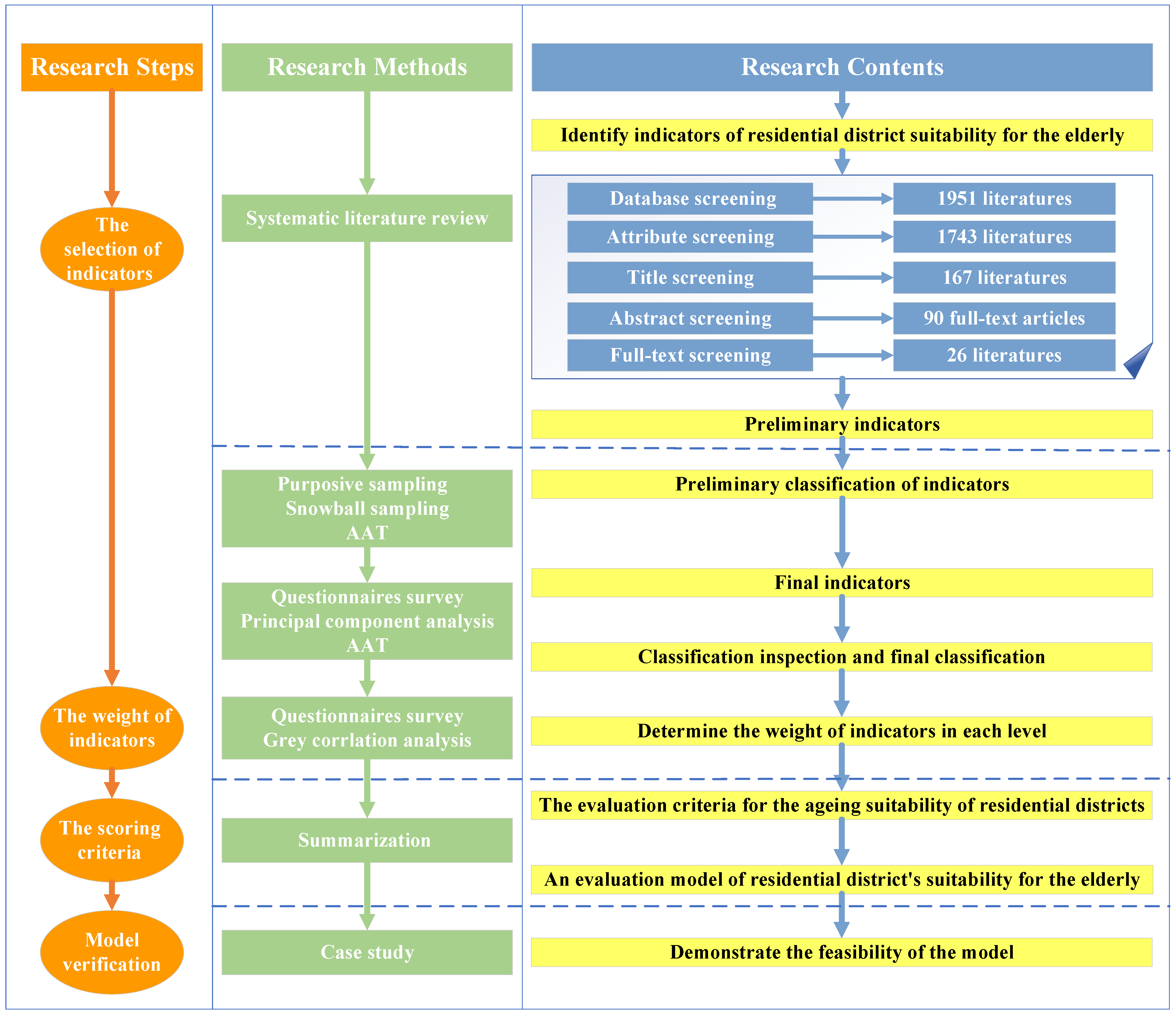
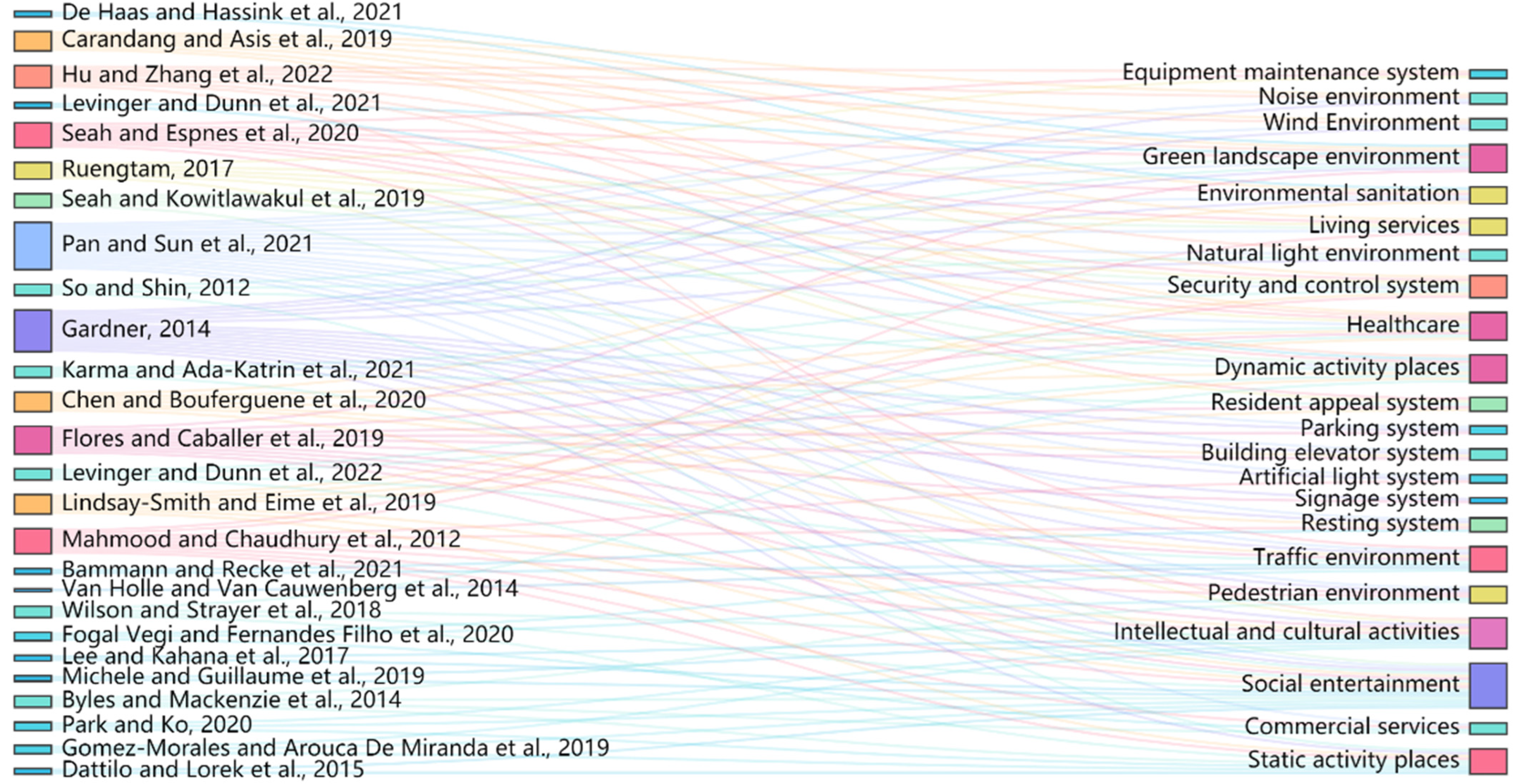
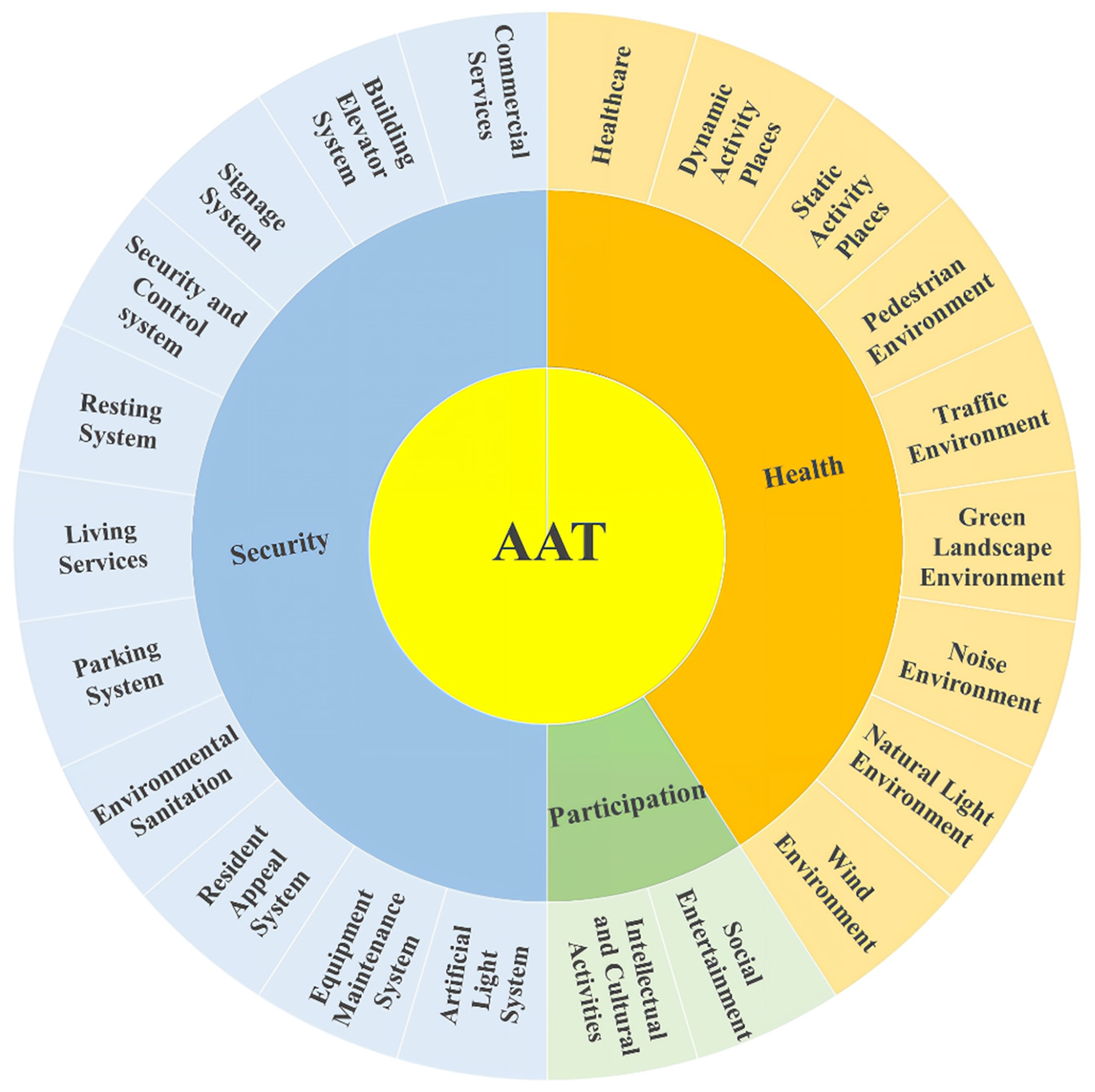
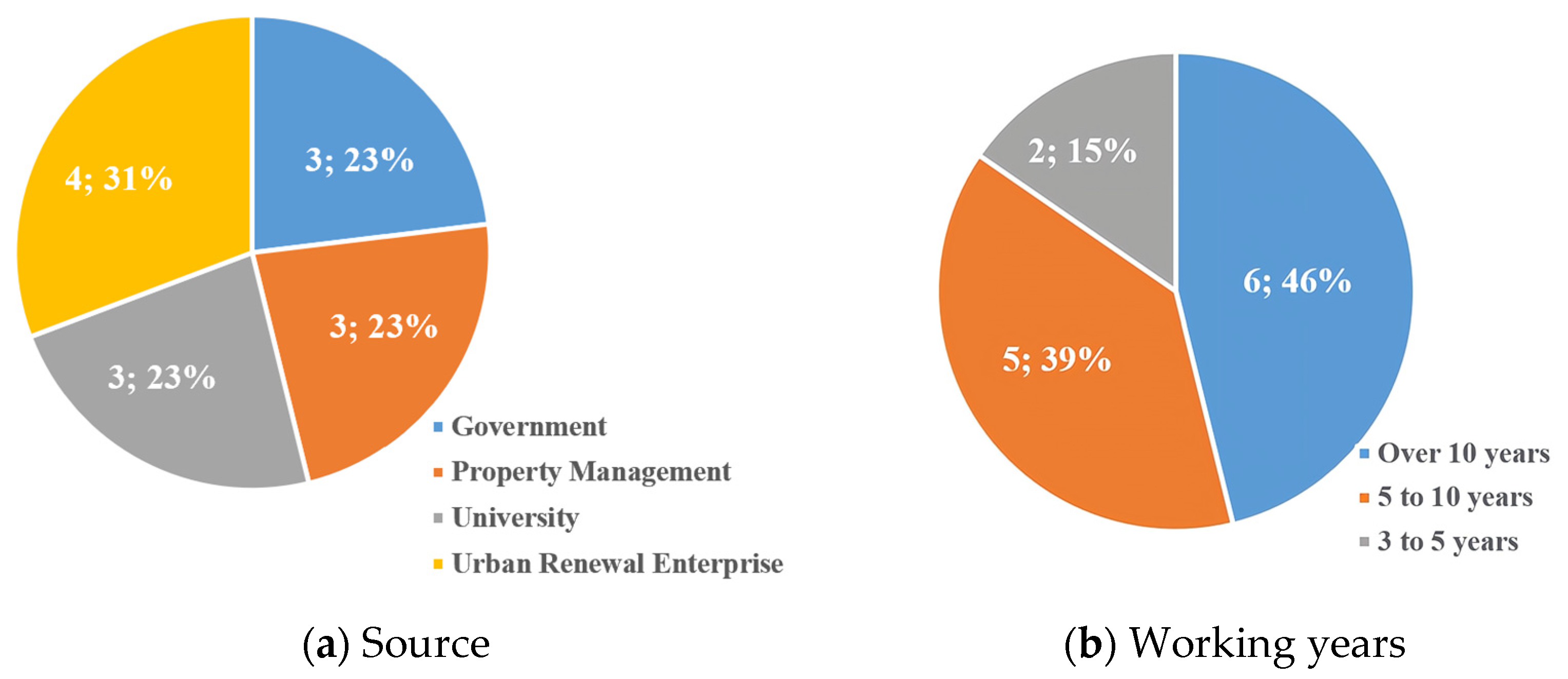
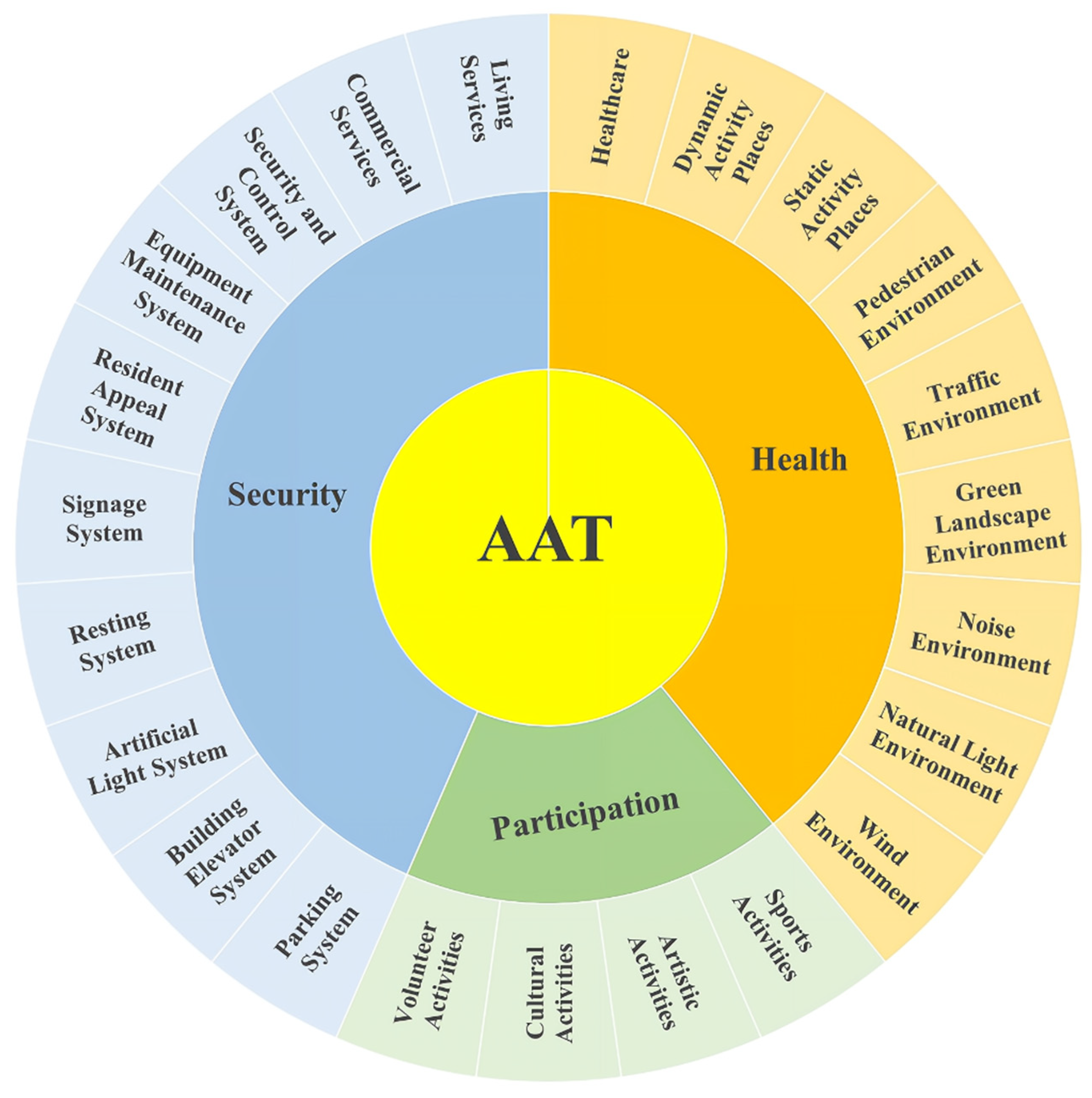
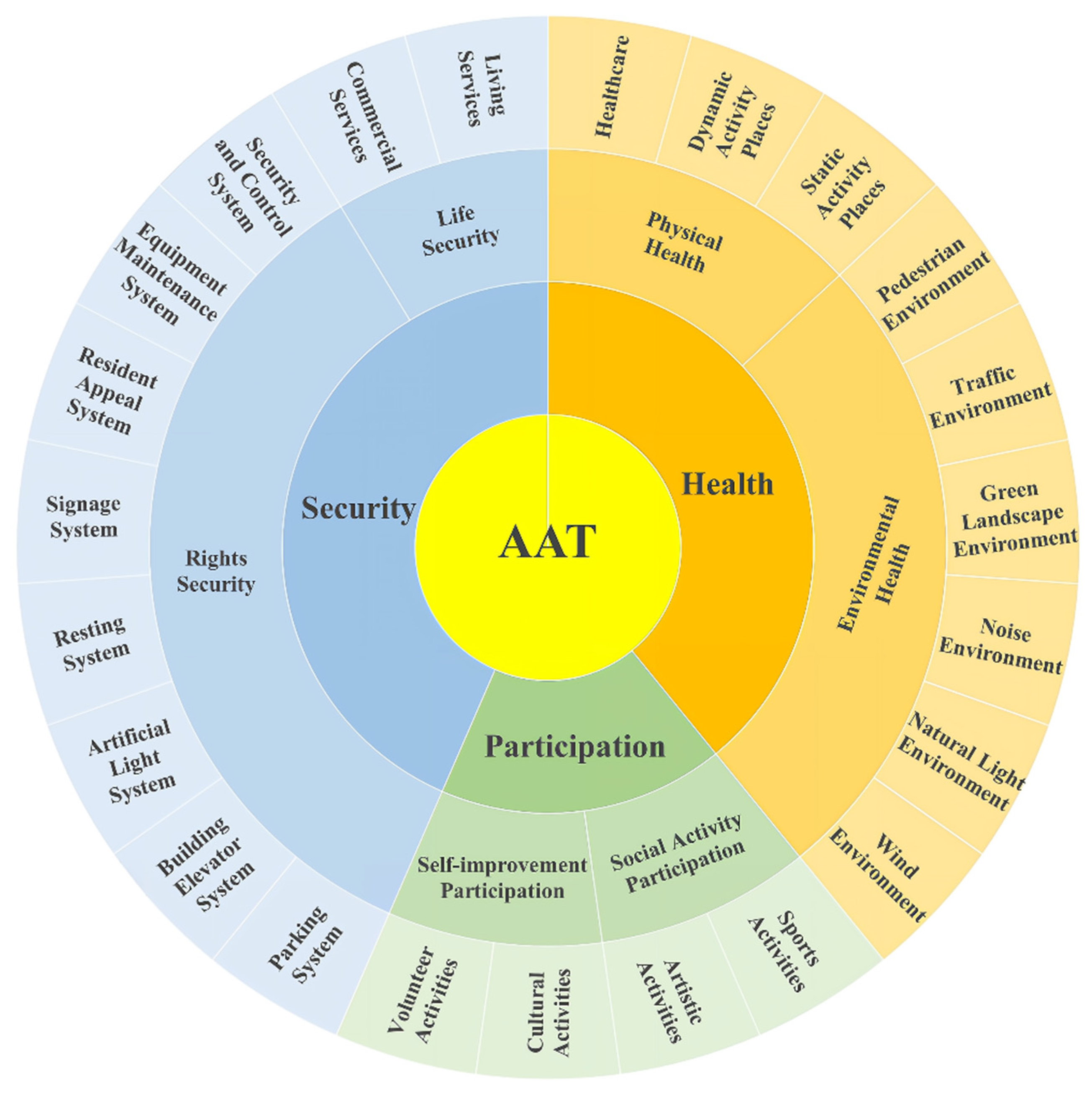
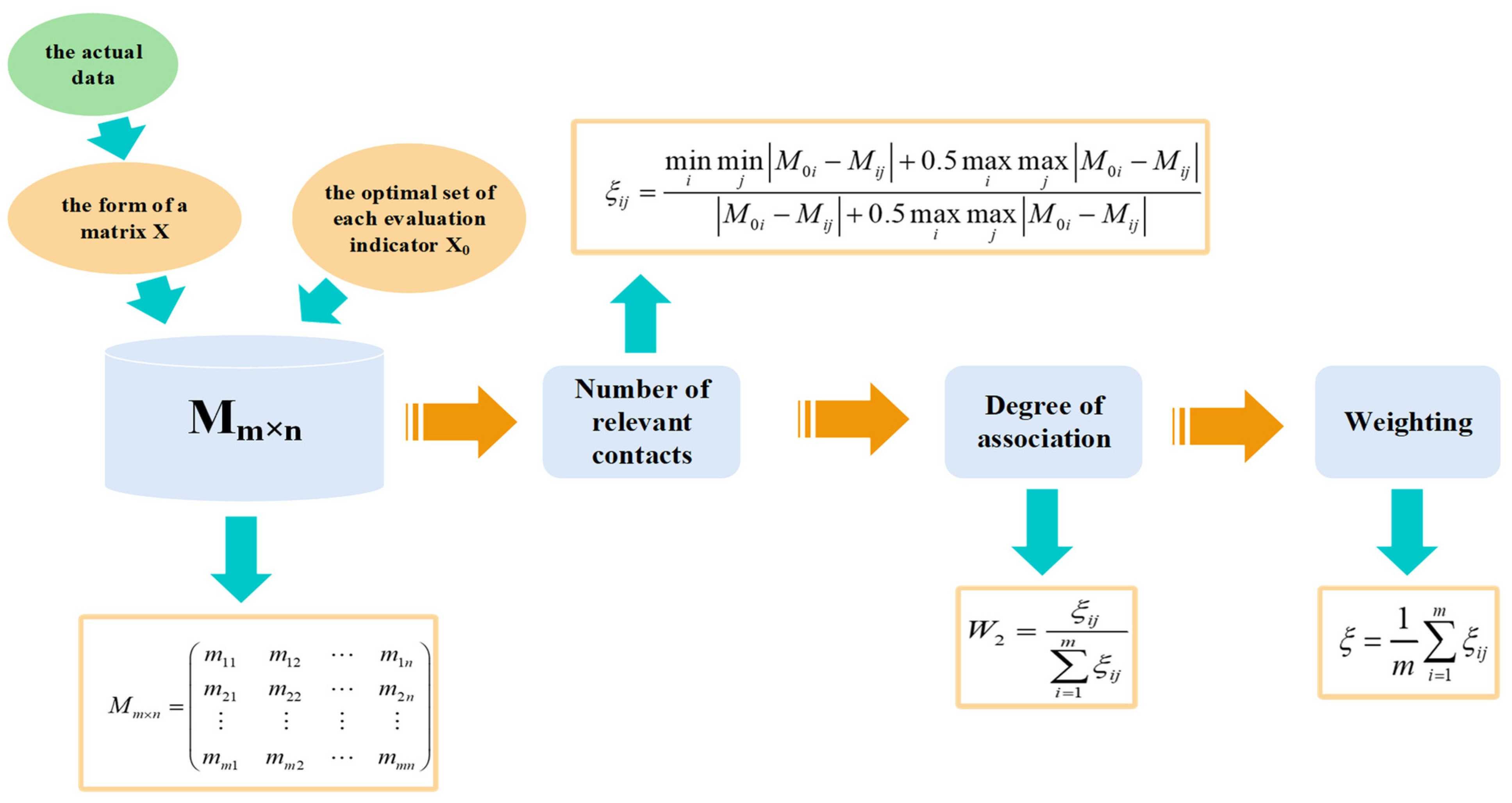




| Indicator | Components | |||||
|---|---|---|---|---|---|---|
| 1 | 2 | 3 | 4 | 5 | 6 | |
| Equipment Maintenance System | 0.919 | |||||
| Security and Control System | 0.904 | |||||
| Resident Appeal System | 0.886 | |||||
| Building Elevator System | 0.871 | |||||
| Artificial light System | 0.856 | |||||
| Resting System | 0.829 | |||||
| Signage System | 0.823 | |||||
| Parking System | 0.737 | |||||
| Noise Environment | 0.923 | |||||
| Wind Environment | 0.915 | |||||
| Natural Light Environment | 0.908 | |||||
| Pedestrian Environment | 0.876 | |||||
| Green Landscape Environment | 0.867 | |||||
| Traffic Environment | 0.837 | |||||
| Static Activity Places | 0.876 | |||||
| Healthcare | 0.846 | |||||
| Dynamic Activity Places | 0.835 | |||||
| Commercial Services | 0.923 | |||||
| Living Services | 0.854 | |||||
| Volunteer Activities | 0.879 | |||||
| Cultural Activities | 0.838 | |||||
| Sports Activities | 0.887 | |||||
| Artistic Activities | 0.852 | |||||
| First-Level | Weight | Secondary | Weight | Indicator | Weight |
|---|---|---|---|---|---|
| Health (H) | 0.394 | Physical Health, (H1) | 0.500 | Healthcare (H11) | 0.386 |
| Dynamic Activity Places (H12) | 0.258 | ||||
| Static Activity Places (H13) | 0.356 | ||||
| Environmental Health, (H2) | 0.500 | Pedestrian Environment (H21) | 0.190 | ||
| Traffic Environment (H22) | 0.133 | ||||
| Green Landscape Environment (H23) | 0.194 | ||||
| Noise Environment (H24) | 0.124 | ||||
| Natural Light Environment (H25) | 0.186 | ||||
| Wind Environment (H26) | 0.174 | ||||
| Particiption (P) | 0.313 | Social Activity Participation, (P1) | 0.464 | Sports Activities (P11) | 0.447 |
| Artistic Activities (P12) | 0.553 | ||||
| Self-improvement Participation, (P2) | 0.536 | Cultural Activities (P21) | 0.488 | ||
| Volunteer Activities (P22) | 0.512 | ||||
| Security (S) | 0.293 | Rights Security, (S1) | 0.579 | Parking System (S11) | 0.094 |
| Building Elevator System (S12) | 0.133 | ||||
| Artificial Light System (S13) | 0.132 | ||||
| Resting System (S14) | 0.136 | ||||
| Signage System (S15) | 0.136 | ||||
| Resident Appeal System (S16) | 0.123 | ||||
| Equipment Maintenance System (S17) | 0.123 | ||||
| Security and Control System (S18) | 0.123 | ||||
| Life Security, (S2) | 0.421 | Commercial Services (S21) | 0.328 | ||
| Living Services (S22) | 0.672 |
| General Objective | Total Score | First-Level, Score | Secondary, Score | Indicator, Score |
|---|---|---|---|---|
| Ageing suitability evaluation of residential districts | 74.53 | H, 75.11 | H1, 74.96 | H11, 66.67 |
| H12, 71.21 | ||||
| H13, 86.67 | ||||
| H2, 75.25 | H21, 85.19 | |||
| H22, 50.00 | ||||
| H23, 92.31 | ||||
| H24, 72.22 | ||||
| H25, 75.00 | ||||
| H26, 66.67 | ||||
| P, 76.55 | P1, 77.65 | P11, 50.00 | ||
| P12, 100.00 | ||||
| P2, 75.60 | P21, 50.00 | |||
| P22, 100.00 | ||||
| S, 71.59 | S1, 80.01 | S11, 55.56 | ||
| S12, 67.36 | ||||
| S13, 73.33 | ||||
| S14, 66.67 | ||||
| S15, 100.00 | ||||
| S16, 100.00 | ||||
| S17, 72.22 | ||||
| S18, 100.00 | ||||
| S2, 60.02 | S21, 80.56 | |||
| S22, 50.00 |
Disclaimer/Publisher’s Note: The statements, opinions and data contained in all publications are solely those of the individual author(s) and contributor(s) and not of MDPI and/or the editor(s). MDPI and/or the editor(s) disclaim responsibility for any injury to people or property resulting from any ideas, methods, instructions or products referred to in the content. |
© 2023 by the authors. Licensee MDPI, Basel, Switzerland. This article is an open access article distributed under the terms and conditions of the Creative Commons Attribution (CC BY) license (https://creativecommons.org/licenses/by/4.0/).
Share and Cite
Xu, Y.; Liu, H.; Su, S.; Mao, P. Ageing Suitability Evaluation of Residential Districts Based on Active Ageing Theory. Buildings 2023, 13, 1041. https://doi.org/10.3390/buildings13041041
Xu Y, Liu H, Su S, Mao P. Ageing Suitability Evaluation of Residential Districts Based on Active Ageing Theory. Buildings. 2023; 13(4):1041. https://doi.org/10.3390/buildings13041041
Chicago/Turabian StyleXu, Yuxin, Hui Liu, Shu Su, and Peng Mao. 2023. "Ageing Suitability Evaluation of Residential Districts Based on Active Ageing Theory" Buildings 13, no. 4: 1041. https://doi.org/10.3390/buildings13041041
APA StyleXu, Y., Liu, H., Su, S., & Mao, P. (2023). Ageing Suitability Evaluation of Residential Districts Based on Active Ageing Theory. Buildings, 13(4), 1041. https://doi.org/10.3390/buildings13041041






